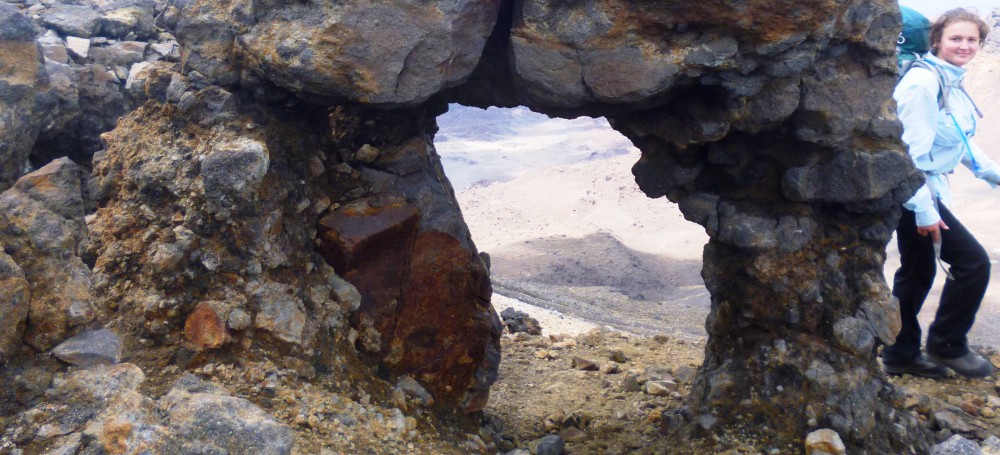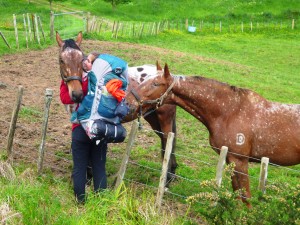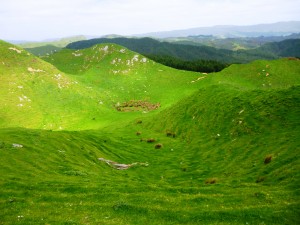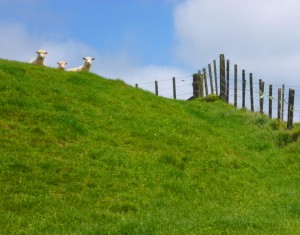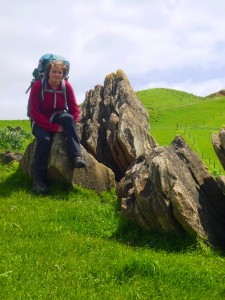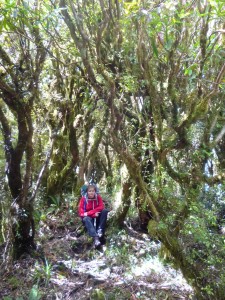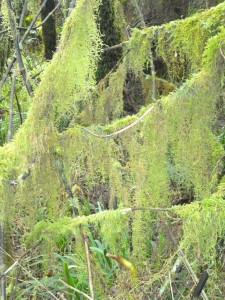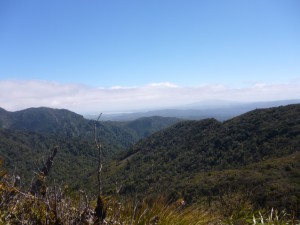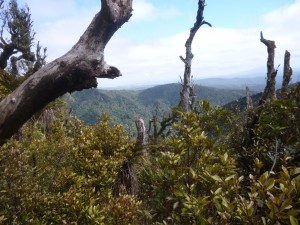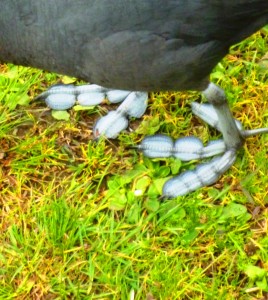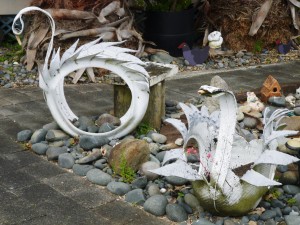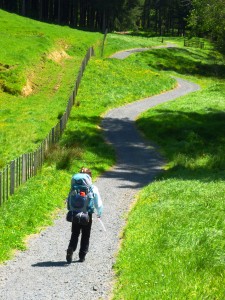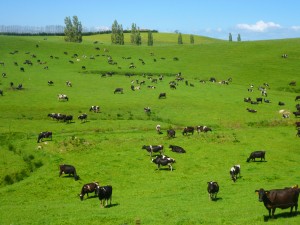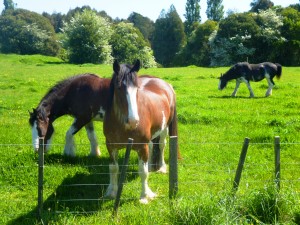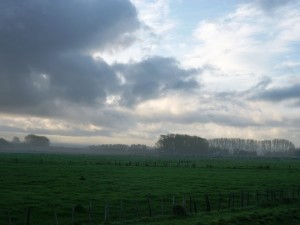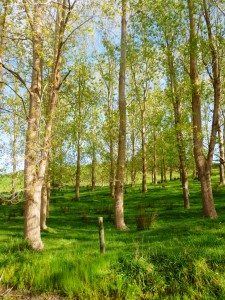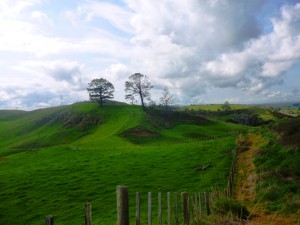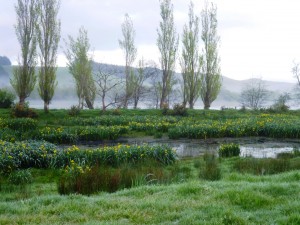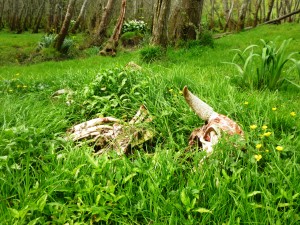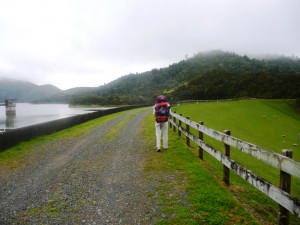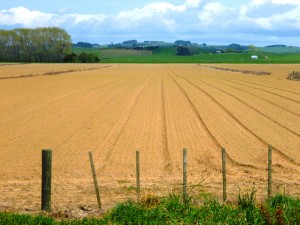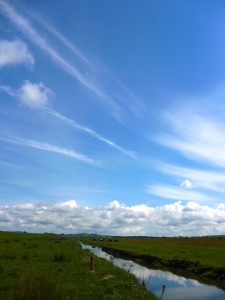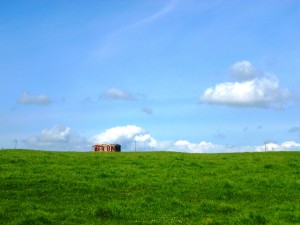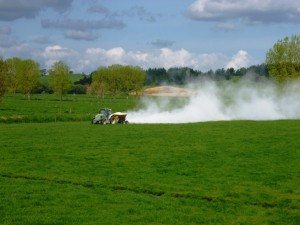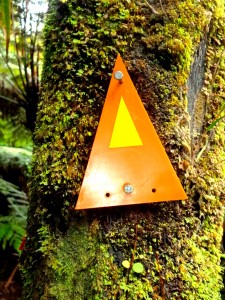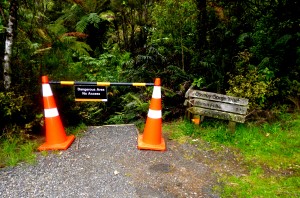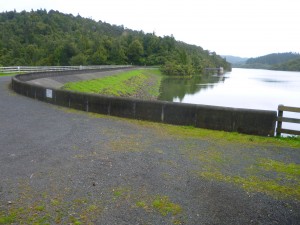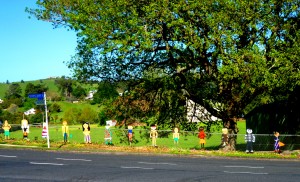This blog entry is written by Marius, because he wanted to have some Dad-and-daughter time on the trail. I stayed at home to watch TV, eat pink cupcakes and file my claws. I also washed the dog’s bedding. I am a domestic goddess.
Day 1
Thursday, 10 October
Rangiriri to Huntly (20 km)
The bus driver cheerfully announced that passengers do not so much disembark at Rangiriri as get tossed out at speed on the SH1, because there is no other reason to stop in this little town. We achieved a decent rolling fall, dusted ourselves down and set off.
This was the start of my first trek with Hannah and I felt energetic, striding ahead like Gandalf. Behind me, my daughter’s laconic comment was that I wouldn’t last very long if I carried on like this. “Conserve your energy, Dad!” was the first of many bits of trail-wise advice from a hardened veteran of 630 km of North Island trail.
The first section was on a kind of causeway through farmlands. Accompanied by some bullocks swinging their wedding vegetables ahead of us, we walked at a pleasant pace, Hannah wearing the new hiking boots that her grandmother had sponsored. The Bivouac salesman warned that the boots had to be broken in gradually – one hour at the start of the day, one hour at the end.
Conversation picked up and with it, the pace as Hannah enthused about new friendships and reflected on the vicissitudes of the past year. After climbing over numerous stiles (some with steps missing and one with steps actually collapsing as we climbed over), we finally got to Huntly’s golf course and had the target firmly in sight: Huntly’s twin towers: the two orange smokestacks of the country’s largest thermal power station. Its service includes Auckland. I’m typing here by means of electrons that have travelled more than 100km.
Soon after the golf course, we put on rain jackets against the squalls. Past the power station, we still had a few kilometres still ahead to find the camping ground where we were supposed to spend the night. Sore and exhausted, we crossed to the Waikato River’s east bank, over a graffiti’d footbridge. The inviting river bank was a possible campsite because the official camping ground was too far a limping distance. We sat on the bank and consulted maps, notes and GPS.
A group of preadolescent boys from the nearby Maori community clustered around us. “Where you from? Where you going? What are you of each other?” they demanded. Trying to explain in our oxygen-deprived, befuddled way who we were and what we were doing, we asked if they knew certain roads indicated on our notes. No, they didn’t know these roads. Eventually they lost interest in us and drifted off. I heard one explain cheerfully to an onlooker: “They from Auckland and they walking to Hamilton but they don’t know what the f*** they doing!” That wasn’t an bad summation, actually.
We headed out of town along the trail to find a camping spot; light was failing and we were getting decidedly hungry – father and daughter think alike when it comes to food. On Riverview Road, Hannah set up kitchen on a picnic table while I searched for a reasonably concealed spot to pitch Samson. After wolfing down the cooked freeze-dried lamb and fettuccini (surprisingly tasty) we put the tent up under the overhanging branches of a willow tree.
Unfortunately, there was a gentle slope to the ground, and we spent a restless night gathering ourselves up from pooling at the foot-end of the tent. I was all the while thinking about the warning in the trail notes that the river bank could be a treacherous place to camp, as flooding could happen very quickly in the wet season. Finally I got to sleep, only to wake up (minutes? an hour?) later to a whooshing, rushing sound. I jumped bolt upright in stark panic and shook Hannah. “Hanny! Wake up! The river! We’ve got to get out!” And then I realised the sound was a train on the nearby railway line. Well. Not much sleep after that, especially when the wind gathered strength and made ominous, low, whistling sounds through the willow branches.
Day 2
Friday, 11 October
Huntly to somewhere in the Hakarimata Range (11 km)
We groggily broke camp under kitchen window scrutiny of an elderly couple, Dorothy and Peter. They invited us for coffee and biscuits when I went to beg for some water to top up 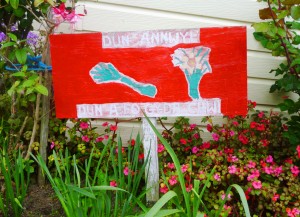 our 2-litre container. Peter showed us his Welsh answer to Maori blessings and rituals: the words mean (more or less) “Welcome and God bless you”. By the way “Welcome” in Te Reo Maori is “Haere mai”.
our 2-litre container. Peter showed us his Welsh answer to Maori blessings and rituals: the words mean (more or less) “Welcome and God bless you”. By the way “Welcome” in Te Reo Maori is “Haere mai”.
After a few footwear changes, Hannah settled with her supportive and waterproof boots, just as we got to the Hakaramita reserve and started climbing the very well-maintained stairs up the northern end of the range. And we climbed. And climbed. Luckily, we were offered some views as we progressed vertically, although a clear day would have permitted better photographs.
We finally got to the spot where Te Araroa parts ways with the scenic reserve and immediately all path maintenance disappeared. “This is more like what Mom and I are used to!” was Hannah’s comment. Boy oh boy. Mud, more mud and Jacob’s ladders of tangled roots that served sinister stairs. I was seated very abruptly a number of times, much to my daughter’s mirth. I had my revenge by torturing her with silly songs and groan-inducing puns.
I am amazed at how Hannah has cultivated vasbyt. This South African term literally means “to bite tight”. It comes from the days of conscription in the SA army, where you were given gruelling exercises and circumstances to cultivate physical and psychological toughness. Today, where I was sweating and groaning up the Jacob’s ladders, Hannah was scaling them with seeming ease and control. I guess walking Ninety Mile Beach and wading upstream in Waitangi has to put some marrow in bones that are not made for wishing.
All the while I was hoping for a clear space to set up camp, but the nikau palms, kauri and ti trees formed a gauntlet that pushed us ever forwards, with the occasional break where we would sit balanced awkwardly on a jutting root and have a jelly sweet. I was also not too keen to pitch the tent within felling distance of one of the trees which might give up its struggle against the ever-present wind.
Eventually, at mid-afternoon, we came across what seemed like a firebreak that bisected the trees. It was wide enough to pitch Samson comfortably. No sooner had we put the tent up and settled in, when the rain began. We felt snug and smug and feasted on our Mexican rice meal with cheese mixed in. It’s amazing how wonderful a simple meal like that can taste when you have only had some nuts for breakfast, some jelly sweets for lunch and a few cookies for morning tea. I complimented Hannah on being the best cook ever, especially when the meal was followed by freeze-dried trifle. I was thoroughly impressed at the way she managed our camp and assumed the Trail Boss role, which is normally Mairi-Anne’s.
After dinner, Hannah read me some Adrian Mole, said goodnight and was asleep at 4.30 pm. I tossed and turned until well after dark, listening to the high-pitched calls of the fantail and another bird which I used to think was the silvereye (very much like the SA Cape white-eye). However, listening to various birdcall websites since coming home, it seems I’m mistaken and the cheerful, randomly tuneful little call will have to belong to an anonymous avian for now.
Later, I was woken by the sound of a V8 doing burnouts in the treetops, roaring around the neighbourhood like a boy racer hoon. Luckily, the stands of ti trees on both sides of the firebreak sheltered us from this gale, so the tent didn’t flap too much. In the wee hours there was distant thunder and lightning, but only a smattering of rain.
Day 3
Saturday, 12 October
Somewhere in the Hakarimata Range to Hamilton (25 km)
The morning started with our first glimpse of sun since Thursday, but again with the roar of thunder in the distance. And of course more wind. Mairi-Anne texted us the weather forecast, which included “gales in exposed places” and admonished us not to expose our places. Despite the din, I also heard a plate of bacon, eggs and chips calling my name from Ngaruawahia, so we got going promptly.
After the previous night’s rain there was even more mud and, to our surprise, the fresh bootprints of other trampers! We wondered who would be so crazy as to venture out in this weather. We were only there because Mairi-Anne made us do it.
Today we employed the foot version of mountain bike “granny gear”. This is the lowest gear on the bike, one which allows you to pedal up steep hills using less energy and at a slower pace than the high-ratio gears. We took short steps up the steep bits instead of the “let’s get this over with” strides of the previous day, and it actually worked: we got to the tops of these climbs without feeling totally puffed out. A great thing about this section of Te Araraoa is that it is extremely well signposted: whenever the track disappears, there is a very clear triangle pointing the way.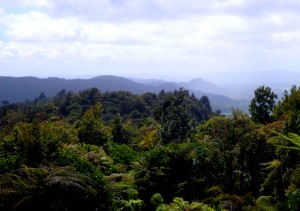
On one of the climbs, a tramper who was going in the opposite direction told us he’d started on the track “at the bottom of the stairs” 40 minutes ago. Yay! We thought. Nearly 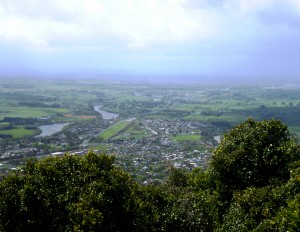 there. Of course he wasn’t carrying a 15kg pack, but we let the illusion of “nearly there” motivate us and presently we came to the helipad with the viewing platform, from where we could look back in astonishment to how far we had walked. We could also see how far down the steps the little town with the funny name was.
there. Of course he wasn’t carrying a 15kg pack, but we let the illusion of “nearly there” motivate us and presently we came to the helipad with the viewing platform, from where we could look back in astonishment to how far we had walked. We could also see how far down the steps the little town with the funny name was.
So we started the descent. According to one website, 1,349 of them. It certainly felt like 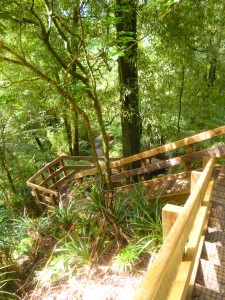 that much, and we welcomed the simple luxury of a handrail to aid the burning knees in bearing the impact of breaking gravity bit by bit, stair by stair.
that much, and we welcomed the simple luxury of a handrail to aid the burning knees in bearing the impact of breaking gravity bit by bit, stair by stair.
Eventually we reached a pleasant valley of gushing streams, waterfalls and fit-looking ladies jogging in pink trainers, before exiting into the town of (OK, here we go) Ngaruawahia (got that?). The sky made a real commitment to rain as we searched for an eatery (I was so sure of that meal calling my name). Then… heaven: the Bakery & Café with seating inside and exactly the breakfast of my fantasy.
The last of our water had run out on the trail that morning so we topped up at the public toilets and got a few provisions for our last shift. It started with a long trek along the SH1 with more rain. Three Fonterra milk tankers passed us and gave us a thorough spraying of our undercarriage. It is strangely beautiful how you can get sodden from both north to south and south to north. On three occasions sympathetic motorists stopped and offered us a lift. With real anguish, we declined. Hannah offered, “We’re doing it for fundraising” as our reason. I’m glad she didn’t say, “We’re doing it for mental health awareness”, because to that the response could only be, “I can see why!”
Pukete Road led us through some equestrian lifestyle blocks (plots, as we called them in SA) to the bank of the Waikato, for the start of the Riverside Walk in Hamilton. On the opposite bank we could see the houses of the fabulously wealthy and some stormwater pipes gushing from that bank into the river. My killer pun of the day: “Affluent effluent.”
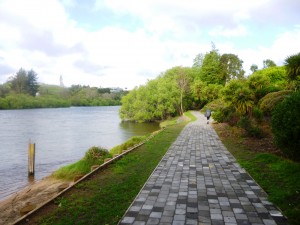 The riverside pathway is a long stretch of beautifully manicured parkland and smoothly-paved walkway shared by cyclists, joggers and pram-pushing parents. [Blog interruption by Mairi-Anne: Beware of pram-pushers! First, they let you push a pram with absolutely no obligation. Then you start to buy prams. After a while you have nowhere to hide all your prams and the perpetual monkey-grip position of your hands tells the world you are a pram handle addict. To hide your shameful habit you have to make babies to fill all the prams and you are trapped in a terrible, vicious cycle!] We were greeted with canine effervescence by some dogs and slight disdain by their attendant humans.
The riverside pathway is a long stretch of beautifully manicured parkland and smoothly-paved walkway shared by cyclists, joggers and pram-pushing parents. [Blog interruption by Mairi-Anne: Beware of pram-pushers! First, they let you push a pram with absolutely no obligation. Then you start to buy prams. After a while you have nowhere to hide all your prams and the perpetual monkey-grip position of your hands tells the world you are a pram handle addict. To hide your shameful habit you have to make babies to fill all the prams and you are trapped in a terrible, vicious cycle!] We were greeted with canine effervescence by some dogs and slight disdain by their attendant humans.
We hadn’t expected to come this far today, but Hannah was insistent that we get to the CBD (tomorrow’s destination for catching the bus). There was nowhere to stealth camp, so we had to push on but Hannah’s feet were sore and my legs froze up every time we stopped to rest.
After 7.00 pm, we finally found a backpackers’ inn that wasn’t fully booked. We gratefully had a proper shower (not a Fonterra tanker one) and then bed. A real bed. Good night!
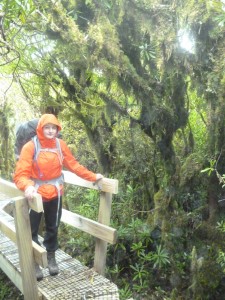 To lure Hannah out of bed, I told her with almost tearful excitement that we’d be starting the day’s trudge on the Noel Sandford Boardwalk south of the camp. You have no idea how brilliant it is to walk on a constructed pathway suspended well above the bogs, even if this thrill lasts for only a couple of kilometres. Noel Sandford, whoever you are, we blow kisses in your general direction.
To lure Hannah out of bed, I told her with almost tearful excitement that we’d be starting the day’s trudge on the Noel Sandford Boardwalk south of the camp. You have no idea how brilliant it is to walk on a constructed pathway suspended well above the bogs, even if this thrill lasts for only a couple of kilometres. Noel Sandford, whoever you are, we blow kisses in your general direction.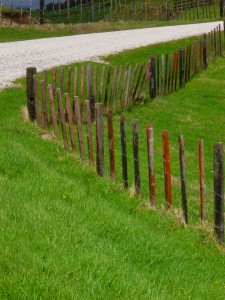 leaves and branches in one direction due to the prevailing wind. The road gravel is white, making a flashing contrast to the relentlessly green turf and fence posts stained with red lichen.
leaves and branches in one direction due to the prevailing wind. The road gravel is white, making a flashing contrast to the relentlessly green turf and fence posts stained with red lichen.